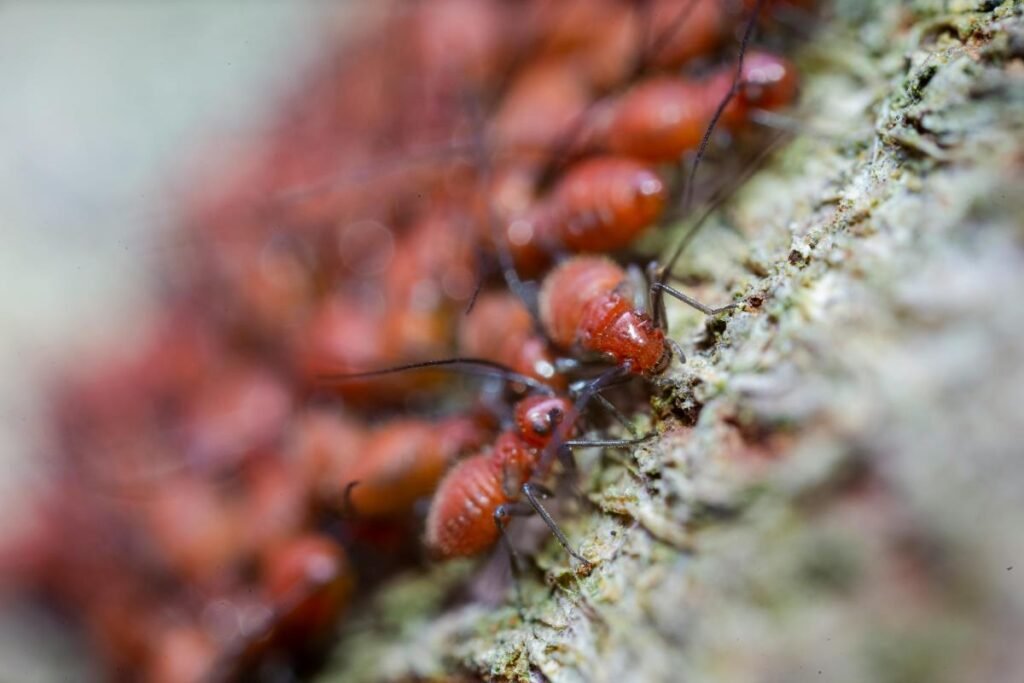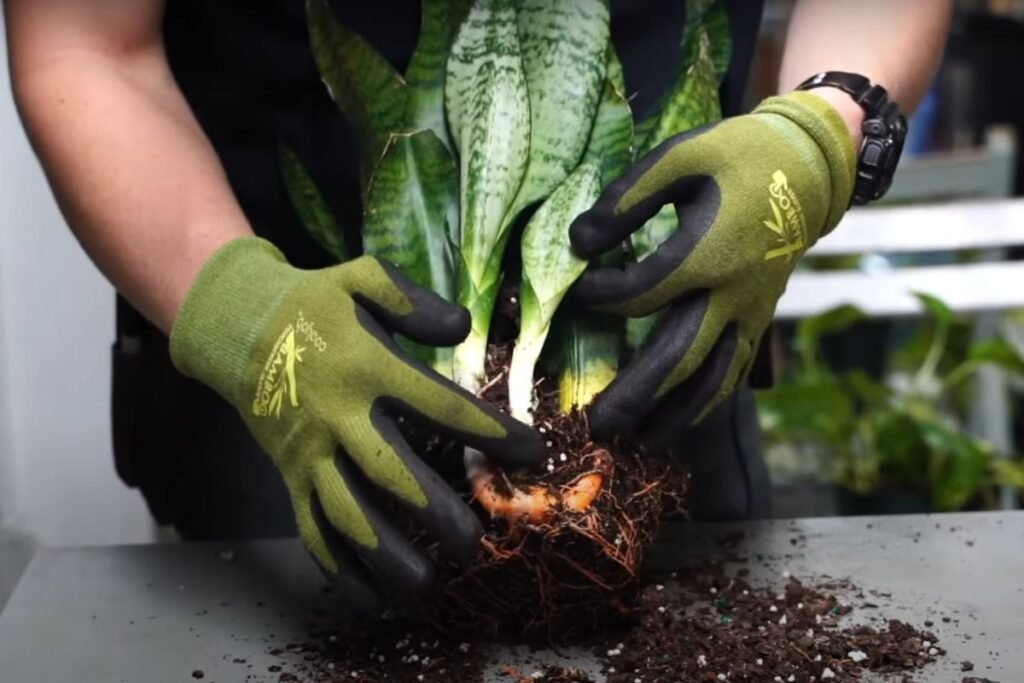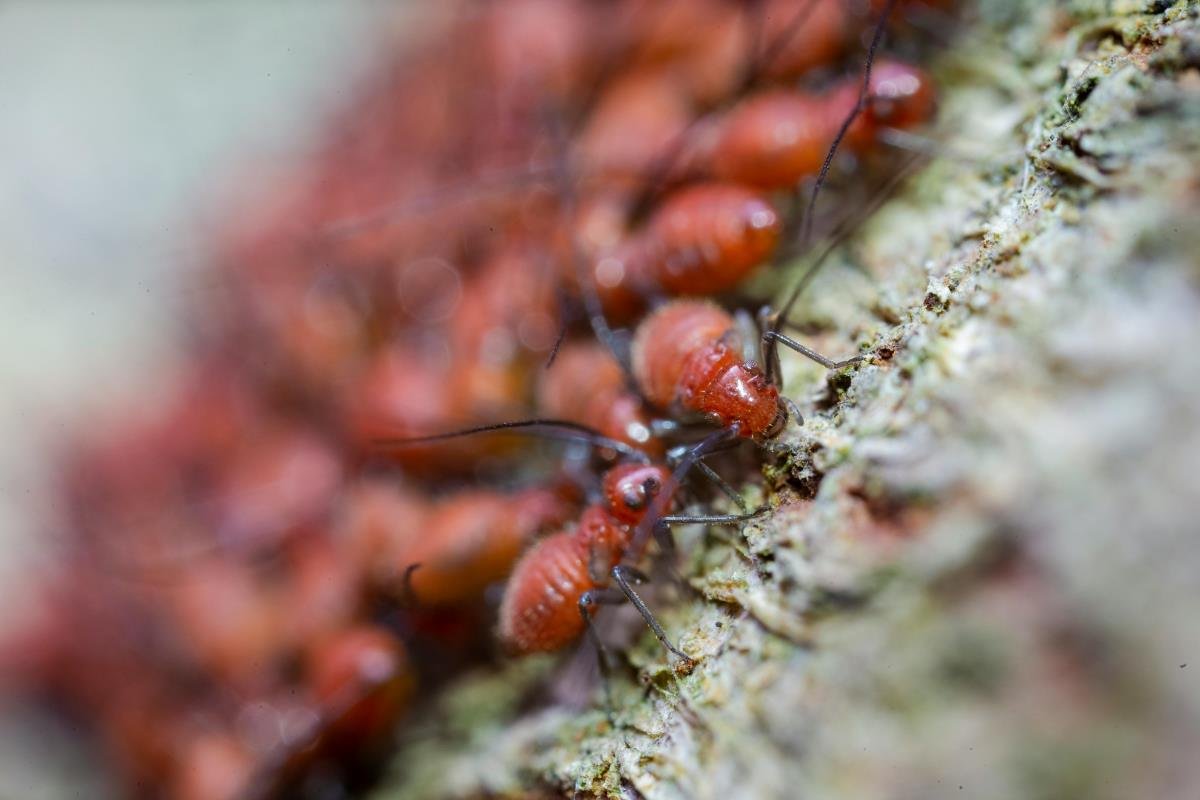I still remember the day I spotted insects in my snake plant soil. Tiny black dots moving around in the soil of my beloved two-year-old snake plant. At first, I thought my eyes were playing tricks on me. But there they were – insects making themselves at home in my plant’s pot.
I’d been so proud of how well my snake plant had grown. Its tall, sword-like leaves had become a striking feature in my living room. But now I had uninvited guests threatening all my hard work.
What followed was a journey of discovery, frustration, and ultimately, success. I managed to save my plant by completely changing the soil and replanting the healthy parts. Through this experience, I learned so much about the tiny creatures that can live in our houseplants’ soil.
Today, I want to share everything I discovered about insects in snake plant soil – what they are, why they appear, and most importantly, how to get rid of them for good.

Table of Contents
Common Insects That Invade Snake Plant Soil
Let’s talk about the bugs you might find in your snake plant soil. Knowing what you’re dealing with is the first step to fixing the problem.
Fungus Gnats
These tiny flying insects look a bit like fruit flies. They love moist soil and feed on organic matter and fungus. While adult gnats are just annoying, their larvae can damage your plant’s roots.
Fungus gnats are often the first sign that you’re overwatering your snake plant. These plants like to dry out between waterings, and too much moisture creates the perfect home for these pests.
When I found gnats in my snake plant, I noticed they would fly up in a small cloud whenever I watered or moved the pot. Their larvae – tiny white worms with black heads – lived in the top layer of soil.
Spider Mites
Though they prefer leaves, spider mites can also hang out in the soil. These tiny arachnids are so small they often look like moving dust. They suck the sap from plants, leaving behind yellowing leaves and fine webbing.
Spider mites thrive in dry, warm conditions – the opposite of fungus gnats. If your home has low humidity, your snake plant might attract these pests.
Mealybugs
These white, cotton-like bugs love to cluster in plant crevices and soil. They feed on plant sap and excrete a sticky substance called honeydew, which can lead to mold.
Mealybugs move slowly, making them easier to spot than some other pests. They often start on the leaves but can spread to the soil.
Scale Insects
Scale insects attach themselves to plants and look like small bumps rather than insects. They can be brown, tan, or black. Like mealybugs, they suck plant juices and produce honeydew.
Some types of scale can live in soil during part of their life cycle. They’re tough to spot until the infestation gets bad.
Springtails
These tiny insects jump when disturbed. While they look alarming, springtails actually feed on decaying matter and fungi in the soil, not on your plant.
Springtails are a sign of overly moist conditions but aren’t usually harmful to snake plants. Think of them as tiny janitors cleaning up rotting material.
Root Mealybugs
These pests look like regular mealybugs but live exclusively in the soil and on roots. You might not know you have them until your plant starts declining for no apparent reason.
When I repotted my infected snake plant, I discovered some white, powdery substances around the roots – classic signs of root mealybugs.
Why Insects Appear in Snake Plant Soil
Understanding why bugs show up in the first place can help you prevent future problems. Here are the main reasons insects invade snake plant soil:
Overwatering
This is the number one cause of soil insects. Snake plants are drought-tolerant succulents that need very little water. When we water them too much or too often, we create a moist environment that’s perfect for pests.
I learned this lesson the hard way. Before my bug problem, I was watering my snake plant every week, thinking I was being a good plant parent. In reality, I was creating a bug paradise.
Poor Drainage
Even with proper watering, if your pot doesn’t drain well, water collects at the bottom. This creates a damp zone that attracts insects.
Check your pot for drainage holes. Also, make sure you’re using well-draining soil meant for succulents or cacti.
Contaminated Soil
Sometimes the problem arrives with the plant or soil. Store-bought potting mix can contain insect eggs or larvae if it wasn’t properly sterilized.
New plants might bring hitchhikers with them. Always check new additions carefully before bringing them home.
Organic Matter in Soil
Rich soils with lots of organic material break down over time. While this is great for many plants, it can attract pests to your snake plant.
Snake plants prefer leaner soil mixes with less organic matter. Too much compost or rich materials creates food for bugs.
Indoor-Outdoor Transitions
If you move your snake plant outside during summer, it may pick up insects before coming back in.
I used to place my snake plant on the balcony during warm months. Looking back, this could be how my insect problem started.
Signs Your Snake Plant Has Soil Insects
How do you know if bugs have moved into your snake plant soil? Watch for these tell-tale signs:
Visible Insects
The most obvious sign is seeing the bugs themselves. Check the soil surface and around the pot’s drainage holes.
Look closely at the space where the soil meets the pot. Many insects hide in this gap.
Flying Insects Around the Plant
If tiny flies zoom up when you water or disturb the plant, you likely have fungus gnats.
These flies are most active at dusk and dawn. Try checking your plant during these times if you suspect gnats.
Sticky Residue on Leaves or Nearby Surfaces
Honeydew from sap-sucking insects can make leaves shiny or sticky. You might even notice it on the floor or table under your plant.
Ants are attracted to honeydew, so an ant problem near your snake plant could signal the presence of scale or mealybugs.
Yellowing or Wilting Leaves
When insects damage roots or steal plant nutrients, leaves may turn yellow or begin to droop.
My snake plant’s outer leaves started yellowing from the bottom up. I first thought it was normal aging, but it was actually a sign of the root damage from pests.
White, Cottony Spots in Soil or on Roots
This could indicate root mealybugs or fungus. Either way, it’s not normal and needs attention.
When I finally pulled my plant from its pot, the white spots on the roots confirmed my suspicions about an infestation.
Plant Growth Slows or Stops
Snake plants are slow growers anyway, but if yours seems to have stopped completely, pests might be stealing its energy.
Compare recent photos of your plant if you’re not sure. Sometimes the decline happens so gradually we don’t notice.
How Soil Insects Harm Snake Plants
Some soil dwellers are merely annoying, while others can seriously damage or kill your plant. Here’s what they do:
Root Damage
Larvae of certain insects feed directly on roots, cutting off the plant’s ability to absorb water and nutrients.
Even minor root damage can stress your snake plant, making it more vulnerable to disease.
Spreading Disease
Many pests carry or create conditions for fungal and bacterial diseases.
The honeydew produced by some insects encourages sooty mold, which can block light from reaching leaves.
Weakening the Plant
Even if bugs don’t kill your plant outright, they can weaken it by stealing nutrients.
A weakened snake plant grows more slowly and becomes more susceptible to other problems like sunburn or cold damage.
Spreading to Other Plants
Once established, many insects will travel to nearby houseplants, turning one problem into many.
I noticed my nearby pothos developing similar symptoms a few weeks after I spotted bugs in my snake plant. The pests had spread faster than I realized.
Getting Rid of Insects in Snake Plant Soil

Now for the part you’ve been waiting for – how to evict those unwanted tenants from your snake plant’s home.
Soil Replacement (What Worked for Me)
The most effective solution is often to completely replace the soil. Here’s how I did it:
- I carefully removed my snake plant from its pot
- Gently shook and washed off all the old soil from the roots
- Inspected roots carefully and cut away any damaged or infested parts
- Let the roots dry for a day to kill any remaining pests
- Disposed of the old soil far from other plants
- Cleaned the pot thoroughly with hot, soapy water
- Replanted in fresh, well-draining cactus soil
This method worked wonders. My snake plant bounced back within weeks and has been pest-free since.
Organic Pest Control Methods
If your infestation is minor or you prefer not to repot, try these organic approaches:
Diatomaceous Earth
This powder-like substance consists of fossilized aquatic organisms. It’s sharp at a microscopic level and cuts through insect exoskeletons, causing them to dehydrate and die.
Sprinkle a thin layer on top of the soil. Reapply after watering.
Neem Oil Solution
Neem oil disrupts insect life cycles and acts as a natural repellent.
Mix 2 teaspoons of neem oil with 1 teaspoon of mild liquid soap in 1 quart of warm water. Water your plant with this solution instead of regular water every two weeks until the problem resolves.
Hydrogen Peroxide Drench
A hydrogen peroxide solution can kill larvae and eggs in the soil while providing extra oxygen to roots.
Mix 1 part 3% hydrogen peroxide with 4 parts water and use this to water your plant. The soil will fizz – this is normal and means it’s working!
Beneficial Nematodes
These microscopic worms hunt and kill pest larvae in the soil without harming your plant.
Follow package directions to mix them with water and apply to soil. They need to be kept moist to work effectively.
Chemical Solutions
For severe infestations, you might need stronger measures:
Systemic Insecticides
These are absorbed by the plant and kill insects that feed on any part of it. They can be very effective but should be used carefully.
Look for products containing imidacloprid for indoor plants. Always follow label directions precisely.
Insecticidal Soap
Less harsh than many chemicals but still effective against many soft-bodied insects.
Spray directly onto visible bugs and the soil surface. Reapply weekly until the problem resolves.
Soil Drench Insecticides
These specialized products are mixed with water and applied directly to the soil.
Follow package directions carefully and keep pets and children away from treated plants.
My Personal Experience
When I discovered bugs in my snake plant’s soil, I first tried hydrogen peroxide drenches. This helped temporarily, but the insects returned after a few weeks.
Next, I tried diatomaceous earth on the soil surface, which seemed to reduce the adult insects but didn’t completely solve the problem.
Finally, I decided to take drastic action. I unpotted my plant, washed away all the soil, and examined the roots. Some sections had been damaged by the pests, so I carefully cut these away with clean scissors.
After letting the roots dry overnight, I replanted into a freshly cleaned pot with new cactus soil mixed with extra perlite for drainage. I waited a week before watering to make sure any remaining eggs or larvae would die in the dry soil.
It was nerve-wracking to be so aggressive with a plant I’d had for two years, but it worked! My snake plant not only survived but thrived. Within two months, it even produced a new pup – a sure sign it was happy again.
Preventing Future Insect Problems
An ounce of prevention is worth a pound of cure. Here’s how to keep bugs away for good:
Proper Watering Practices
Allow your snake plant’s soil to dry completely between waterings. In winter, this might mean watering only once a month.
Check soil moisture with your finger or a wooden skewer before watering. If it feels damp or the skewer comes out with soil sticking to it, wait longer.
Good Soil Mix
Use a fast-draining soil mix designed for cacti and succulents. You can make your own by mixing regular potting soil with perlite or pumice at a 1:1 ratio.
The coarser texture allows water to flow through quickly rather than staying soggy.
Quarantine New Plants
Keep new houseplants separate from your existing collection for at least two weeks. Watch for any signs of pests before introducing them to your plant family.
I now have a special spot near a bright window where newcomers spend their first few weeks, safely distant from my other plants.
Regular Inspections
Make it a habit to check your plants weekly. Look at the soil surface, under leaves, and around the pot’s rim for early signs of trouble.
I keep a magnifying glass near my plant care supplies now. It’s amazing what you can spot with a little magnification!
Avoid Overfeeding
Snake plants need very little fertilizer. Too much can create an environment that attracts pests.
If you do fertilize, use a balanced fertilizer at quarter strength, no more than twice a year.
Keep Leaves Clean
Dust on leaves can harbor pests and their eggs. Wipe snake plant leaves occasionally with a damp cloth.
Clean leaves are also better at photosynthesis, keeping your plant strong and naturally pest-resistant.
When to Say Goodbye
Sometimes, despite your best efforts, a plant might be too far gone to save. Here are signs it might be time to start over:
- The roots are completely rotted
- New leaves keep dying despite treatment
- The infestation returns repeatedly despite thorough treatment
- The plant has stopped growing entirely for several months
If you do need to dispose of an infested plant, seal it in a plastic bag before throwing it away to prevent spreading pests to outdoor plants.
The Silver Lining
My experience with soil insects taught me valuable lessons about snake plant care. I now understand these plants much better and have developed habits that keep all my houseplants healthier.
The scare of almost losing my favorite plant made me more attentive to all my green friends. In a way, those pesky bugs did me a favor!
Snake Plants After Treatment: What to Expect
After dealing with soil insects, your snake plant will need time to recover. Here’s what you might notice:
Initial Shock
Don’t panic if your plant looks worse right after treatment. Major interventions like repotting can cause temporary stress.
My snake plant drooped a bit after its soil change. I nearly panicked, but within a week, it had perked up again.
New Growth Patterns
As your plant recovers, new growth might appear in unexpected places. The plant might send up pups from areas of the rhizome that weren’t damaged.
After clearing up my plant’s pest problem, I noticed new growth emerging from the base rather than from the existing leaves’ edges as before.
Slower Growth at First
Your plant will direct energy toward root recovery before showing obvious above-soil growth. Be patient during this time.
It took about a month after treatment before I saw any new leaves on my snake plant. But by six weeks, it was clearly thriving again.
Myths About Snake Plant Pests
Let’s clear up some common misconceptions I’ve encountered:
Myth: Snake Plants Repel Insects Naturally
While snake plants are indeed hardy, they don’t actively repel pests. They can and do get infested like any houseplant.
Myth: Bugs in the Soil Mean Your Plant is Dying
Not necessarily. Many plants can tolerate some soil insects without serious harm. Early intervention usually saves the plant.
Myth: Adding Rocks to the Pot Bottom Improves Drainage
This actually creates a perched water table where moisture collects, potentially attracting more pests. Better to use the right soil mix throughout.
Myth: Insects Only Come from Outdoors
Indoor plants can develop pest problems even if they’ve never been outside. Eggs and larvae can arrive in new soil, on new plants, or even on your clothing.
Final Thoughts
Dealing with insects in your snake plant soil can feel overwhelming. I remember the disappointment and worry when I first discovered my plant’s uninvited guests. But with prompt action and the right approach, most infestations can be successfully treated.
My snake plant not only survived its bug ordeal but is now stronger than ever. The experience taught me to be more attentive to subtle signs of problems and to be proactive about plant care.
Remember that even experienced plant parents face pest issues sometimes. It’s not a reflection of your green thumb skills but simply a normal part of living with houseplants.
Has your snake plant faced a pest invasion? What worked for you? I’d love to hear your experiences in the comments below!
Happy growing!
My name is Shahriar Robin, and my journey with plants began in childhood, igniting a lifelong passion that blossomed alongside my career as a nutritionist and sports trainer. Through SnakePlant.org, I channel this dedication, merging expertise from nutrition and sports training to nurture a platform sharing all-encompassing knowledge about Snake plants. This website mirrors my commitment to cultivating greenery, offering comprehensive insights on growth, maintenance, and nurturing practices for these captivating plants. My mission is rooted in leveraging diverse expertise to enhance plant care practices, believing profoundly in the therapeutic impact of nature. Join me on SnakePlant.org, where I unite a thriving community of enthusiasts, sharing experiences, insights, and the profound joys of planting.

